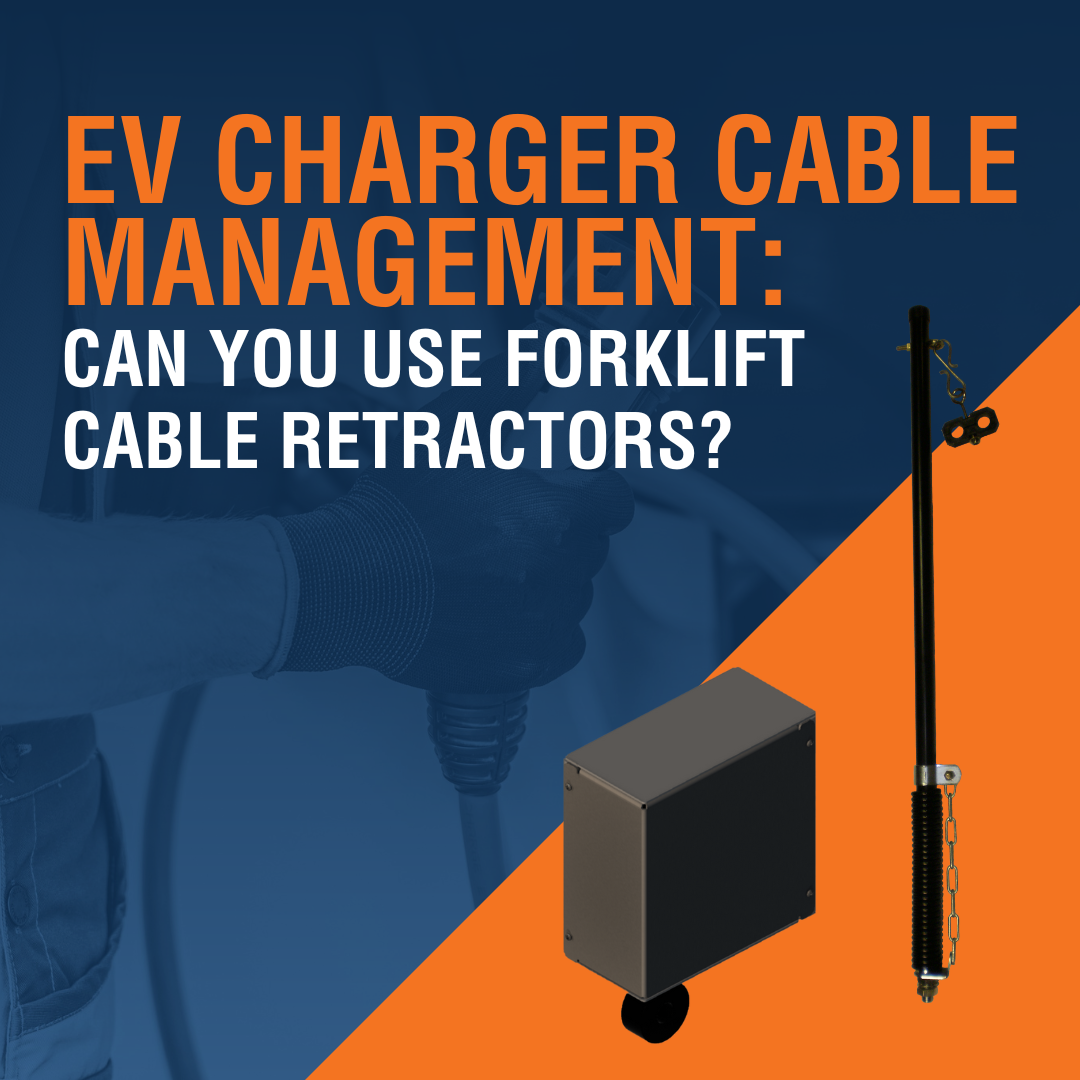We use cookies to make your experience better. To comply with the new e-Privacy directive, we need to ask for your consent to set the cookies. Learn more.
EV Charger Cable Management: Can You Use Forklift Cable Retractors?
Across industries, fleet managers are making plans for electric vehicle (EV) charging stations. They may be municipalities converting bus fleets to electric; distributors upgrading delivery fleets; or manufacturers switching trucks or material handling vehicles to run on electricity. These managers of industrial EV fleets may already be familiar with a decades-old electric vehicle technology: Forklifts. 
The knowledge we gain from electric forklift charging rooms can inform EV fleet infrastructure, but only to a point. Forklifts run on lead-acid batteries. Passenger EVs typically use lithium-ion batteries. The chargers that support each technology have fundamental differences.
But charging stations for forklifts and EVs do have one key similarity: They both require smart cable management to prevent damage to equipment—and reduce the risk of injury for users.
For electric forklifts, OSHA standard 1910.178(g)(2) requires employers to protect “charging apparatus from damage by trucks.” That “apparatus” includes charger cables.
For EVs, the key safety standard (so far) is the National Fire Protection Association’s (NFPA) National Electric Code®, better known as the NEC. Article 625 of this code requires all EV charger cables over 25 feet (7.5 meters) in length to have an appropriate cable management system—and using these EV charger cable management systems for shorter cables is also a wise investment.
If you already run a forklift fleet, you may wonder if forklift cable management systems would work just as well on your EV chargers. They may, but you’ll find EV charger cable management solutions designed for the task will provide more benefits, with fewer headaches. Here’s why.
Comparing Forklift and EV Charger Cable Management Systems
Essentially, cable management systems for forklift chargers and EV chargers do the same thing. They both consist of a clamp and some sort of retractor that pulls cables up and out of harm’s way. For forklift chargers, that may be a pole (as in the “pogo” style Cable Retractor), a spring-loaded retractor reel (as in a Heavy Duty Cable Retractor), or a simple magnetic clamp (as in the Magnetic Cable Mount).
For EV chargers, retractor reels tend to work best. So what’s the difference between a forklift retractor reel and one designed specifically for EV chargers? It boils down to these four factors:
- Compatibility With Charger Support Infrastructure: Heavy Duty Cable Retractors for forklifts are designed to bolt onto Charger Stands or Charger Wall Brackets. They’re drilled to match this infrastructure. EV Charger Cable Retractors, on the other hand, are built for your choice of two mounts: The EV Charger Pedestal, or a charger-adjacent wall. You could retrofit a forklift cable retractor to attach to your Charger Pedestal, but it’s faster, safer, and more cost-efficient to choose the EV Charger Cable Retractor from the start.
- Charging Cable Diameter: Charger cables for electric vehicles are often thicker than their forklift-charging counterparts. That’s why EV Charger Cable Retractors support cables up to 1.5 inches (38 millimeters) in diameter. The clamps on Heavy Duty Cable Retractors adjust to fit cables between 0.5 inches (12.7 millimeters) and 1 inch (25.4 millimeters) in diameter, ideal for most forklift charger cables.
- Resistance to Acid/Electrolyte: All forklift charging infrastructure should be acid-resistant to protect against electrolyte leaks and spills. That’s why Heavy Duty Cable Retractors feature HDPE clamps, which resist damage from contact with electrolyte. This would just be an added expense on an EV Charger Cable Retractor, since lithium-ion batteries don’t use acidic electrolyte.
- Weather Resistance: Electric vehicle charging stations may be indoors or out, which is why EV Charger Cable Retractors are protected by a steel, weather-resistant housing. Most forklift battery rooms are strictly indoors. Heavy Duty Charger Retractors also feature a protective shield, but it’s not designed for indoor/outdoor use like the EV equivalent.
When designing any industrial system, it’s best to choose tools built for a specific application. It is certainly possible to use charger cable retractors built for forklifts in your EV system—but you’ll get faster installation, more benefits, and a greater ROI when you choose EV Charger Cable Retractors for your EV charging infrastructure. Likewise, the Heavy Duty Cable Retractor is an ideal choice for forklift charging rooms.
Regardless of your charging needs, BHS, Inc. has the equipment you need to keep your investments safe. Contact the BHS sales team at 1.800.BHS.9500 to discuss your EV or forklift charging project today.
